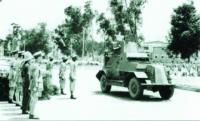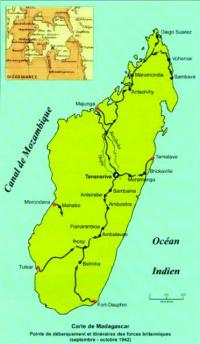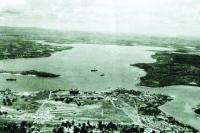This week, seventy years ago, British forces were engaged in the conquest of the Town of Andria Manalina on the Island of Madagascar. This was part of their campaign, which began on May 5, 1942, and would not end until November 6th of the same year, to conquer the French Colony of Madagascar.
Madagascar is the fourth largest island in the world and is located on the eastern side of the African continent, in the Indian Ocean. It currently has a population of almost 22,000,000. At the outbreak of the war, it stood at 4,000,000, 60,000 of whom were French. France began colonizing the island in the 1880's and by 1896, was in full control of the island.
With the conquest of France on June 22, 1940, France came under the sway of the German Reich. Although it continued to administer its colonies, it provided help and assistance to Axis forces. It was this help and assistance to Axis Naval forces that the United Kingdom sought to stifle with its conquest of Madagascar. British Prime Minister, Sir Winston S. Churchill, feared that it would become a "halfway house" for the Axis navies.
As a result of a devastating attack by carrier-based planes of the Imperial Japanese Navy, on April 5, 1942, against the British Naval base at Colombo, Ceylon (now Sri Lanka), and the loss of the base in Singapore, Admiral Sir James Somerville, Commander-in-Chief, Eastern Fleet, ordered that the fleet remove to a new base, at Mombasa, in Kenya.
On March 12, 1942, Prime Minister Churchill decided to preemptively move against the Port of Diego Suarez on the northern end of Madagascar. "Free" French Leader, General Charles de Gaulle, had already suggested such an expedition, but that the French should be involved, or in charge. However, after the disaster at Dakar, Churchill was having none of that. The naval forces would be under the command of Rear-Admiral Edward N. Syfret, with the land portion being under the command of Major-General Robert G. Sturges. General Sturges was described, by author R.H. Bruce Lockhart, as, "...intrepid in action, ruddy in countenance, and forcefully bucolic in language." The operation was to be known as "Operation Ironclad."
The naval force included the Admiral’s flagship, the battleship Ramilles, aircraft carriers Illustrious and Indomitable, heavy cruiser Devonshire, light cruiser Hermione, eleven destroyers, six mine sweepers, six corvettes and several auxiliaries - in all, more than 50 ships. The landing force consisted of three infantry brigades.
Armand Léon Annet was the Governor-General of Madagascar at this time and tasked with defending the Island. Although he had been appointed by French Head of State, Marshal Henri Pétain, on December 11, 1940, he had not arrived at his post until April 12, 1941. The defending force numbered about 8,000, most of which were non-French colonial troops.
The British opened the assault, at 5:10 A.M. on May 5, 1942, with an air attack on Diego Suarez, followed by a landing by the 29th Brigade. The assault, was resisted by three local battalions, one Senegalese and some sailors, totaling between 1500 and 2000, commanded by General Alfred Casimir Eugéne Guillemet. On May 7, the defenders withdrew, having suffered 200 killed and 500 wounded, and the city was surrendered. Fairey Swordfish torpedo bombers launched from the Illustrious had sunk a French armed merchant cruiser and the submarine Béveziérs. Naval action claimed the French submarines Hero and Monge. British casualties were 109 killed and 284 wounded.
Three Japanese submarines arrived on May 29 and with two midget subs, entered the harbor and attacked the Ramilles and seriously damaged it and sank the oil tanker, British Loyalty. Both midget subs were sunk. Two more Commonwealth brigades came ashore on May 10.
By June 10, two of the three British brigades had been withdrawn and sent to India to assist in its defense against the Japanese. During the summer they were replaced by South African, East African and Rhodesian brigades.
In September, the British renewed their assault. The British and East African brigades were landed at the port of Majunga on September 10. Today, it is the city of Mahajanga with a population of 135,000. Governor-General Annet, on September 17, 1942, opened armistice negotiations with the British, but they quickly collapsed. On September 23, the capital of Tananarive was captured and the event celebrated with a victory parade. It is located in the interior of the island and today is known as Antanarivo and has a population of 900,000. At the time of its capture, the population was 1/9 of that. Six days later, Commonwealth forces landed at Tulearon, on the southwest part of the island. Fianarantsoa was captured on October 29. It is located in the south-central part of the island and today has a population of 145,000. On November 6, 1942, Governor-General Annet surrendered near the town of Ihosy, in the southern part of the island. Today the town has a population of 17,000. The French had suffered 1200 casualties, of which half were locals. Since September 10, British casualties were 30 killed and 90 wounded.
Governor-General Annet had achieved his primary objective - extend the struggle for more than six months. This he did by one day. Under French law the defenders were entitled to higher pay and awards if they were involved in combat for more than six months.
General Paul Louis Le Gentilhomme was made Governor-General on December 14. At the outbreak of the war, he had been commander-in-chief of the French military in French Somaliland. He had condemned the Armistice between the German Reich and France and declared his intention to continue fighting with the British. Not everyone in French Somaliland agreed with his position, so, on August 2, 1940, he left for England and joined the "Free" French forces under Charles de Gaulle. He returned to East Africa and participated in the campaign against the Italians, as commander of the "Free" French forces. He later commanded "Free" French forces in the British invasion of Syria. In the meantime, he was tried, and convicted, in absentia, for treason, by the French government in Vichy.
Governor-General Annet ended the war as a convicted war criminal. He died in Paris on April 25, 1973.
Mr. Wimbrow writes from Ocean City, Maryland, where he practices law representing those persons accused of criminal and traffic offenses, and those persons who have suffered a personal injury through no fault of their own. Mr. Wimbrow can be contacted at
wimbrowlaw@gmail.com <mailto:
" title="" href="mailto:wimbrowlaw@beachin.net>">wimbrowlaw@beachin.net> .
NEXT WEEK: THE BATTLE OF SANTA CRUZ ISLANDS






